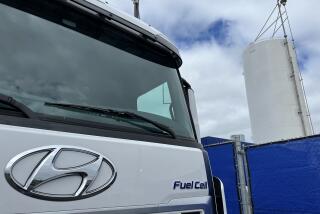Information Highway Leads to Truck Stops
- Share via
At Bruce’s Truck Stop in Bakersfield, long-haul truckers can fuel up, grab a bite to eat, nap--and check their e-mail.
Bruce’s is one of the dozens of truck stops that has installed public-use Internet terminals or simpler e-mail touch screens over the last year. With more drivers traveling with laptops and using e-mail and the Web, truck stops have discovered that offering Internet access is a great way to distinguish themselves from competitors and earn some extra money in the process.
“We’re swamped in the afternoons,” said Judy Marchbanks, marketing manager at Bruce’s, which sits at the intersection of highways 54 and 184. “There’s not a line, but it is used. In a couple years, we’ll see three or four of these booths in our truck stops.”
When Jim Paar, 40, an independent long-haul trucker from Bakersfield, isn’t frequenting chat rooms or browsing the Web, he checks out the weather reports for places he’s bound. Normally Paar logs on from a laptop connected to the Internet via cell phone, but after using an Internet terminal at Bruce’s, he gave it a thumbs up. “It’s a little expensive--25 cents a minute--and I’m usually on there upwards of an hour,” Paar said. “But if they had one in a truck stop, I’d use it because it would save me from using my laptop. It’s the cheaper of two evils.”
USCommunication Services in San Diego has installed 70 PayNet public Internet terminals at Bruce’s and other truck stops since June 1997 and is adding new units every week, said President Jim Brenet. The company charges 25 cents a minute, with a $1 minimum, and shares 25% of the proceeds with truck-stop operators.
Brenet said he underestimated how popular the service would be.
“We were shocked. Our initial results exceeded our pro forma numbers by 300%,” he said. “We had one in Salinas, Kan., that was in use 21.6 hours one day. We’re probably averaging about eight hours a day systemwide per unit. We’re adding second and third terminals in some locations because customers are demanding it.”
Public Internet terminals are a natural for truck drivers, who are often gone for weeks at a time but need to stay in touch with headquarters and home, Brenet and others say. Terminals also have been a boon for trucking companies, which use them to send truckers information about routes, loads and paychecks and to advertise for new drivers.
Difficulties attracting and keeping drivers led trucking-line owner Daryl Deel to start DriverNet, a national network of wall-mounted touch screens with video ads and e-mail access found in 200 truck stops. Deel, chairman of Timm Communications in Joplin, Mo., which operates DriverNet, expects to have 400 units installed by July.
DriverNet terminals don’t have keyboards or offer true Internet access, but Deel expects to roll out second-generation devices by year’s end that do.
Bob Lee can’t wait. Lee is president of Ambest Inc., a Brentwood, Tenn., cooperative of 130 truck stops, 105 of which have DriverNet.
“I’m kicking as hard as I can to get them put in quickly,” Lee said. “That’s the 21st century.”
More to Read
Sign up for Essential California
The most important California stories and recommendations in your inbox every morning.
You may occasionally receive promotional content from the Los Angeles Times.










